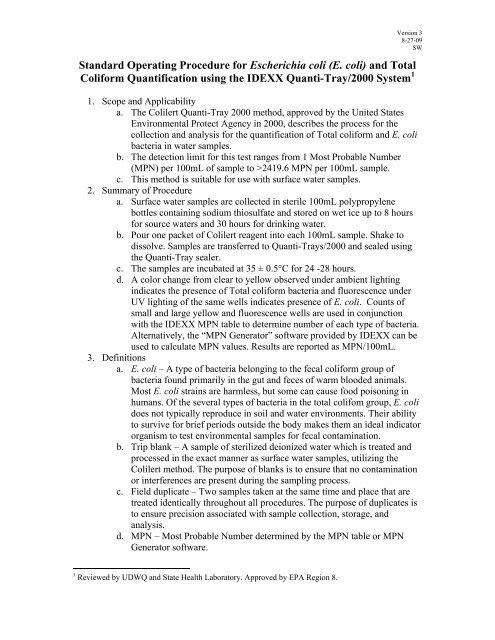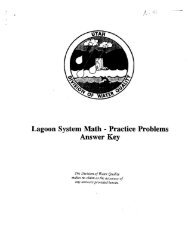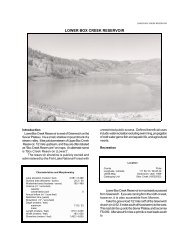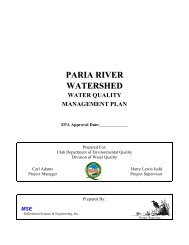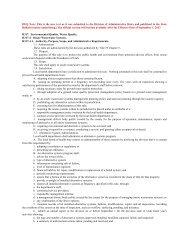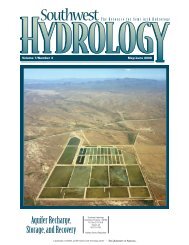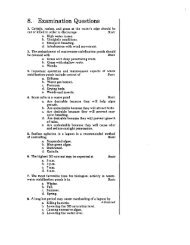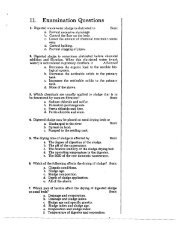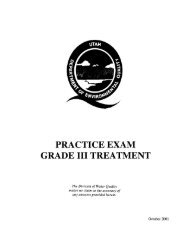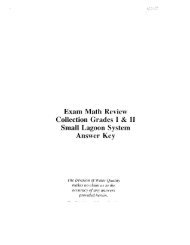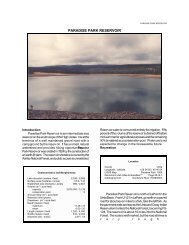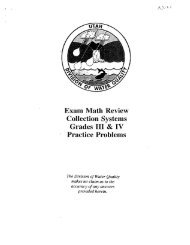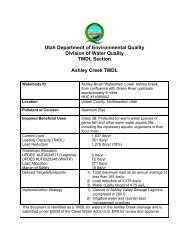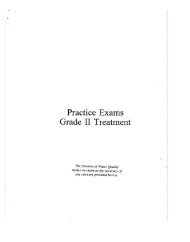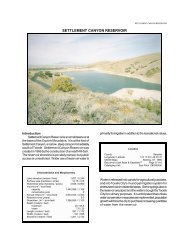Standard Operating Procedure for Escherichia coli - Division of ...
Standard Operating Procedure for Escherichia coli - Division of ...
Standard Operating Procedure for Escherichia coli - Division of ...
- No tags were found...
You also want an ePaper? Increase the reach of your titles
YUMPU automatically turns print PDFs into web optimized ePapers that Google loves.
Version 38-27-09SWiv. If the yellow wells are present, check the same wells <strong>for</strong>fluorescence by using the UV light. Hold the UV light 5 inchesfrom the tray. If the color is equal to or greater than theComparator then count and record the number <strong>of</strong> blue fluorescentwells, both large and small. Blue fluorescent wells are indicative <strong>of</strong>E. <strong>coli</strong>.v. When reading the trip blank and the sterile blank, both shouldremain colorless and nonfluorescent through out the 24h.g. Dilutionsi. There are situations when the numerical value from thebacteriological analysis needs to be an actual number. Thussamples that exceed the threshold, those with concentrations> 2419.6, should be diluted be<strong>for</strong>e analysis takes place whenpossible.ii. A knowledge <strong>of</strong> the source water to be sampled, seasonalvariability, storm events, or known influences can be helpful whendilutions need to be made.iii. If it is unknown if or how much a sample needs to be diluted, Taketwo samples at the sampling site and per<strong>for</strong>m a 1:1 and a 1:10dilution from one bottle and process the other bottle as a wholesample.iv. 1:1 dilutions are made by pipeting 50 mLs <strong>of</strong> sample with a 50 mLsterile disposable pipet into a new sample bottle and then fill thebottle to the 100 mL line with sterile distilled or deionized waterfrom a dedicated carboy or known clean supply. Process thesample as you would a whole sample.v. 1:10 dilutions are made by pipeting 10 mLs <strong>of</strong> sample with a 10mL sterile disposable pipet into a new sample bottle and then fillthe bottle to the 100 mL line with sterile distilled or deionizedwater from a dedicated carboy or known clean supply. Process thesample as you would a whole sample.vi. When interpreting the results from diluted samples remember tomultiply the results by the appropriate factor.vii. Multiply the MPN results from 1:1 diluted samples by 2, andmultiply the results from 1:10 samples by 10 to get the correctresults from the diluted samples.10. Data Analysis and Calculationsa. The determination <strong>of</strong> the MPN/ 100mL <strong>of</strong> both total <strong>coli</strong><strong>for</strong>ms and E. <strong>coli</strong>can be done in one <strong>of</strong> two ways:i. Use the MPN tablesii. Use the IDEXX MPN Generator 3.1. This is the preferred method.1. Download the Generator from IDEXX’s website.www.idexx.com/water/quantitray/index.jsp2. Follow the directions below.a. Click Options5
Version 38-27-09SWb. Enter the file directory <strong>of</strong> where you want yourMPN spreadsheet to be stored. Then click “SaveChanges”.6
Version 38-27-09SWc. Enter your sample date, analyst, and method(Colilert). Type in the name <strong>of</strong> your Sample ID (Ex.4992510 E. <strong>coli</strong>). Note: You might want to labelwhich sample is <strong>for</strong> your E. <strong>coli</strong> and total <strong>coli</strong><strong>for</strong>mshere. Choose which analyte (either total <strong>coli</strong><strong>for</strong>msor E. <strong>coli</strong>) you are calculating. Skip the box <strong>for</strong>“Quanti-Tray Positive Wells (0 to 51)”. This is <strong>for</strong> adifferent method.d. For Total Coli<strong>for</strong>ms, choose total <strong>coli</strong><strong>for</strong>ms <strong>for</strong> youranalyte. Enter the number <strong>of</strong> large yellow (positive)wells in the “Quanti-Tray/2000 Positive LargeWells (0-49)” space and the number <strong>of</strong> small yellowwells in the “Quanti-Tray/2000 Positive SmallWells (0-48)” space. Click on the “Calculate”button. The results are recorded in MPN/100mL.Record these results on the bench sheets. The MPNGenerator also gives you the 95% confidence limits.e. Click on the “Log” button to store these results inthe automatically created spreadsheet.f. For E. <strong>coli</strong>, Choose E. <strong>coli</strong> <strong>for</strong> your analyte. Enterthe number <strong>of</strong> large wells that are both yellow and7
Version 38-27-09SWfluorescent in the “Quanti-Tray/2000 Positive LargeWells (0-49)” space and the number <strong>of</strong> small wellsare both yellow and fluorescent in the “Quanti-Tray/2000 Positive Small Wells (0-48)” space.Click on the “Calculate” button. The results arerecorded in MPN/100mL. Record these results onthe bench sheets. The MPN Generator also givesyou the 95% confidence limits.g. Click on the “Log” button to store these results inthe automatically created spreadsheet.b. To calculate <strong>for</strong> duplicate precision follow the steps outlined in the“<strong>Standard</strong> Methods <strong>for</strong> the Examination <strong>of</strong> Water and Wastewater” (20 thEdition). See attached Appendix.c. The blank samples should have a value <strong>of</strong>
Version 38-27-09SWFigure 1. Overview <strong>of</strong> E. <strong>coli</strong> and Total <strong>coli</strong><strong>for</strong>m Quantification.Collect water samples in 100mL sterile containers.Store samples on wet ice up to 8 hours.Pour 1 packet <strong>of</strong> Colilert reagent into each sample. Shake.Pour solution into Quanti-Trays and seal the trays.For TCIncubate <strong>for</strong> 24 – 28 hours at 35C.For E. <strong>coli</strong>Count # large &small wells.Count # large & smallwells that are bothyellow and fluorescent.Enter # <strong>of</strong> wells inMPN Generator.Enter # <strong>of</strong> wells inMPN Generator.Enter counts(MPN/100ml) onbench sheet.Enter counts(MPN/100ml) onbench sheet.
Version 38-27-09SWColilert Quanti-Tray Method Bench SheetProject/Run:Analyst:Date and Start Time:Date and End Time:Start Temp:Mid Temp:End Temp:Sample ID# LgYellowWells# SmYellowWells# LgFluor.Wells# SmFluor.WellsMPN <strong>for</strong>TCMPN <strong>for</strong>E.<strong>coli</strong>Duplicate10
Version 38-27-09SW<strong>Standard</strong> <strong>Operating</strong> <strong>Procedure</strong> (SOP) Agreement FormDocument Title:<strong>Standard</strong> <strong>Operating</strong> <strong>Procedure</strong> <strong>for</strong><strong>Escherichia</strong> <strong>coli</strong> (E. <strong>coli</strong>) and TotalColi<strong>for</strong>m Quantification using the IDEXXQuanti-Tray/2000 SystemDocument Revision Number:Document Revision Date:Note: The current SOP must be read and SOP Agreement Form signed annually. This<strong>for</strong>m must be kept with the latest version <strong>of</strong> the SOP.I have read and understood the above referenced laboratory document.I agree to per<strong>for</strong>m the procedures described within in accordance withthe document until such time that it is superseded by a more recentapproved revision.Analyst Name (print):Analyst Signature:Date <strong>of</strong> Agreement:Management ApprovalMgt Approval (print):Mgt Signature:Approval Date:11


